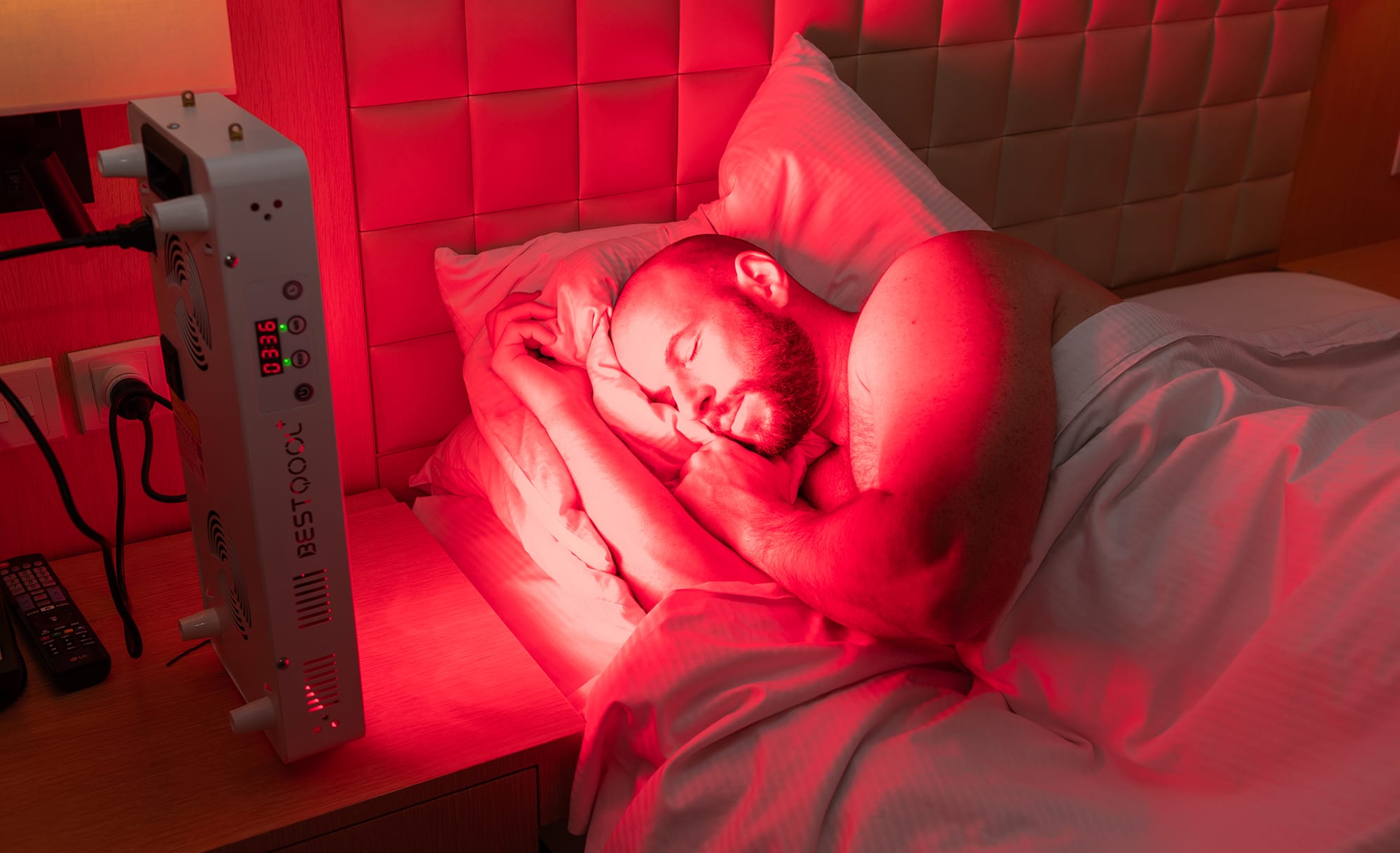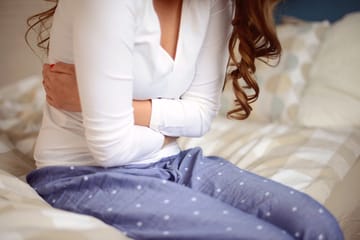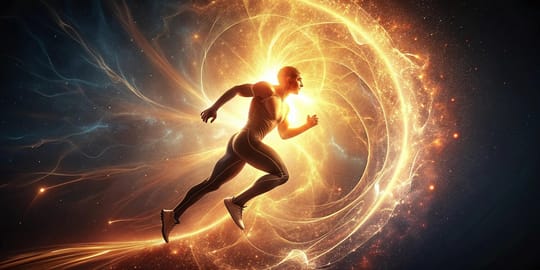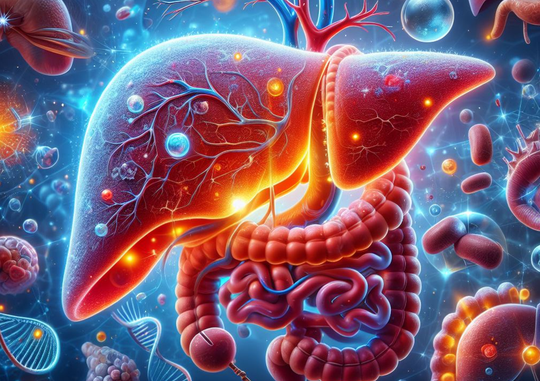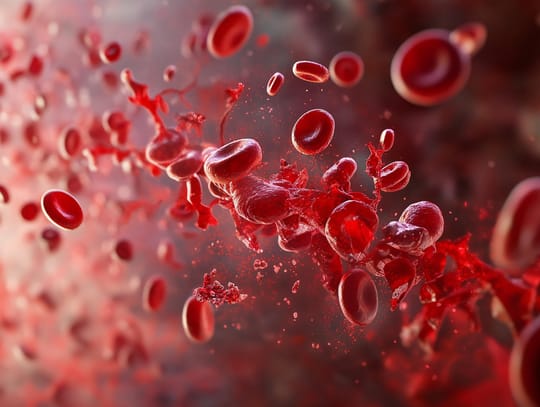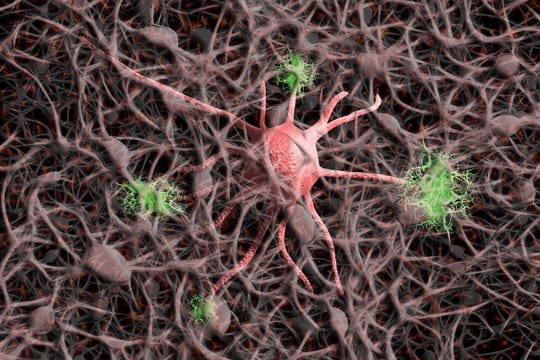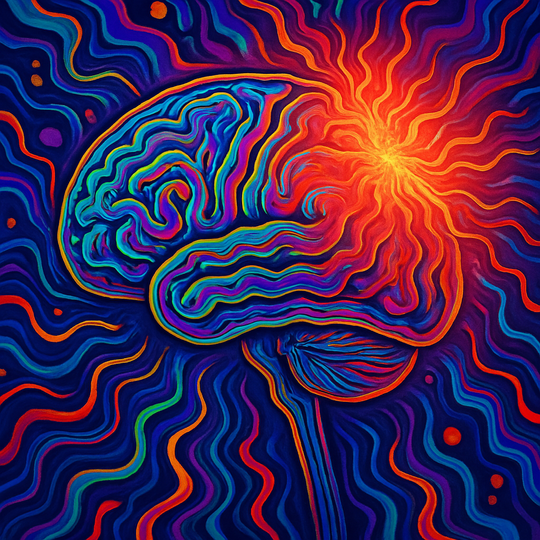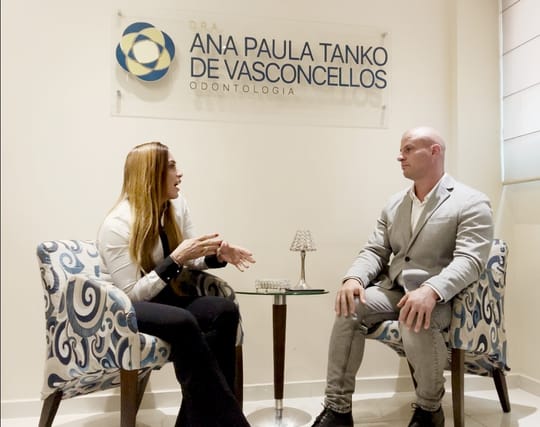In this blog post, I explain the current science and show you some expert opinion on red light therapy for sleep. I'll also tell you about the best devices for red light therapy for sleep, whether red or amber lights in the bedroom are a great idea, and more.
Later on, Alex Fergus - the founder and owner of this website - talks more about the importance of morning sunlight for sleep, as well as how blue light is dangerous for sleep quality especially during the night!
But let's start with the basics below. If you're short on time, read the summary which we've added below:
Quite a few good studies on red light therapy and sleep quality exist. These studies show that you'll get better mood and daytime energy levels, better recovery and performance for athletes, you'll counter cognitive decline, and boost melatonin levels.
Red light therapy affects your body at the cellular level and achieves these benefits through lower inflammation, a boost in energy product, and setting your circadian rhythm (the 24-hour day and night cycle active in your brain and every cell).
However, a lot more research is needed, as there are only a few red light therapy for sleep studies right now! Nevertheless, these studies are very promising. For the best results, you'll need a full-body red light therapy setup that's used in many of these studies or a brain red light therapy device.
Later in this article, we discuss the importance of getting morning sunlight exposure, which contains balanced blue light with red and near-infrared. We also discuss avoiding artificial blue light during the day, especially at night, because it inhibits melatonin production and disrupts cortisol levels. The artificial blue light will considerably affect your circadian rhythm and, therefore, sleep.
Check the article for our complete recommendations! For the best results, you'll get morning sunlight exposure, use red light therapy somewhere during the day, and limit blue light exposure after sunset!
How Red Light Therapy Works For Sleep
Red light therapy works because the light doesn't just hit your skin but penetrates into your body. That way, the red and near-infrared affect you at the cellular level. Red light therapy can lower inflammation across the body, for instance, while increasing energy production.
And, that increase in energy production results in many processes in the human body running much more smoothly. You can think about energy as the universal currency within biological systems - the more energy you have, the better you perform and feel.
Besides energy, many other processes are influenced by light as well. Examples here are the circadian rhythm - the circa 24-hour day and night cycle in your body. And, all of these processes that are affected up to the cellular level also influence sleep.
Below, I'll consider the four main studies that are now published on red light therapy and sleep. These studies explain in detail what sleep-related benefits you can expect:
4 Benefits Of Red Light Therapy For Sleep
Does red light therapy work with sleep? Current science shows that there are benefits of red light for sleep–but not a ton of studies are available on the topic. The studies that do exist, however, are extremely helpful. In total, there are four main studies that look at the effects of red light therapy for sleep quality. I'll consider these studies one by one in detail below:
Study 1: Better Mood, Less Drowsiness, More Quality Of Life
A 2022 study used infrared light only to improve sleep quality (1). That near-infrared light was emitted at the 850nm wavelength. In total, 56 participants were included in the study. All participants had mild sleep complaints. Exposure to the near-infrared occurred five times per week for four weeks. The light therapy was applied in the morning time.
Also, the light therapy was used in both the summer and winter time to deal with seasonal variation. That turned out to be a great choice from the researchers, as decent results were found when red light therapy was applied in the winter but not in the summer.
The explanation here is that many people tend to get much more light exposure during the summertime. The benefits of red light therapy are thereby decreased, the argument goes.
The red light therapy didn't lead to improvements in sleep. But, daytime improvements were noted in this study. Researchers write:
"The results showed PBM treatment only at 6.5 J·cm−2 to have consistent positive benefits on well-being and health, specifically improving mood, reducing drowsiness, reducing IFN-γ, and resting heart rate. This was only observed in winter. No significant effects on sleep or circadian rhythms were noted." (1).
The full text of the study explains a bit more about why this result was found (2).
First up, humans spend 85% of their time indoors, thereby not getting much sunlight exposure. That trend is especially severe in wintertime. Building isolation to save energy also blocks most near-infrared, so that you won't get exposure through windows either.
The near-infrared light was used on the hands, neck, and face of study participants, so it wasn't a full-body setup. Instead, a desk lamp was used. The device also emitted only 5 mW/cm2 as a dose, but was emitted over many minutes and even hours in case of the higher dosages. The study setup was actually extremely extensive if you read the full text of the study (2)
Nevertheless, benefits were found, but only for wakefulness, not sleep quality.
I do think different effects would have been found with a higher dose for deeper tissue treatment and full-body exposure. But fortunately, we can rely on other studies as well:
Study 2: Less Sleep Requirement (Implying Faster Recovery) And More Deep Sleep
Next up, a fascinating study using the NovoTHOR red light therapy device (3; 4). The NovoTHOR is the gold standard for red light therapy beds on the market right now. The NovoTHOR is mainly marketed towards the medical industry but includes clinics as well.
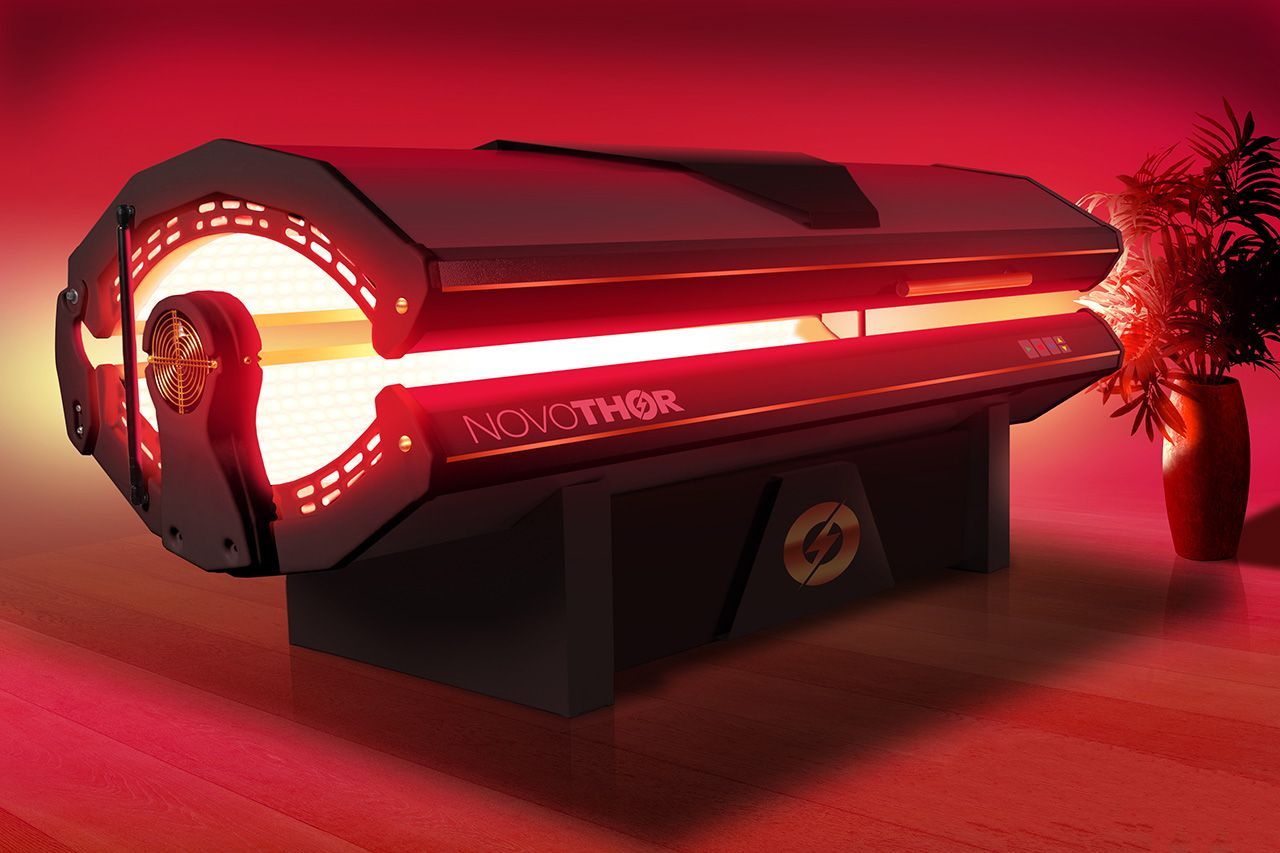
(If you're interested in a NovoTHOR, mention the name Alex Fergus!)
This study is also fascinating because elite female soccer players were included. The women wore an Oura Ring to track sleep quality and also a GPS monitor during training.
So here are the amazing results and conclusion section of the research paper - I'll explain this in plain English below:
"Within-subject comparisons of cardiorespiratory physiology, sleep duration, and sleep composition were evaluated the night before and after PBMT sessions completed as a standard of care for team recovery. Compared to pre-intervention, mean heart rate (HR) was significantly lower the night after a PBMT session (p = 0.0055). Sleep durations were also reduced following PBMT, with total sleep time (TST) averaging 40 min less the night after a session (p = 0.0006), as well as significant reductions in light sleep (p = 0.0307) and rapid eye movement (REM) sleep durations (p = 0.0019). Sleep durations were still lower following PBMT, even when controlling for daily and accumulated training loads. Enhanced cardiorespiratory indicators of recovery following PBMT, despite significant reductions in sleep duration, suggest that it may be an effective modality for maintaining adequate recovery from the high stress loads experienced by elite athletes." (3)
What do these outcomes mean in plain English? First up, the elite soccer players would naturally reduce their sleep time even though they trained very hard.
And, not only was sleep time reduced. The resting heart rate - a sign of how stressed your body is - decreased, which is a favorable recovery sign. And, heart rate variability - the interval between heart beats - also showed signs of quicker recovery. The exact biological mechanisms for these effects aren't given in this study, nor is it described in the scientific literature.
Overall, though, the outcome of this study is extremely promising, as even elite athletes may have significant benefits by shortening their sleep needs, thereby implying improved sleep quality. This study is from 2022 as well
Next up:
Study 3: Red Light Therapy Improves Sleep Quality And Cognitive Performance For People With Cognitive Decline
I can't find a full text of this 2022 study so I can't do a full analysis of the outcome here (5). Suffice it to say that red light therapy was applied to the prefrontal cortex, which is the brain area above your eyes, in patients with subjective cognitive decline.
The study participants were split into a placebo and treatment group. After five days, the treatment group saw increases in the amount of deep and REM sleep they received, while the percentage of light sleep declined.
The participants receiving the light therapy treatment also performed better at a brain test that uses working memory and processing speed called "dual n-back". The prefrontal cortex plays a major role in the performance on that test.
Overall, red light therapy does improve sleep quality in this study.
Study 4: Female Basketball Players Improve Melatonin Levels, Endurance, And Sleep Quality With Red Light
Next up, a study with 20 athletes of the People's Liberation Army (6; 7). The athletes were 18 years old on average and play basketball. Ten of the athletes received red light therapy and ten a placebo. Sleep quality was measured with the Pittsburgh Sleep Quality Index (PSQI). The PSQI is a widely used valid and reliable sleep measurement tool, although imperfect (8; 9; 10).
The athletes also had their melatonin levels measured and did a 12-minute run test. In the intervention group, red light therapy was applied daily for two weeks straight. The red light therapy lasted 30 minutes and was applied with a bed. The wavelength used was 660nm. A 30 J/cm2 dose was applied, which is great for deeper tissue treatment.
Here's the outcome of the study:
"The 14-day whole-body irradiation with red-light treatment improved the sleep, serum melatonin level, and endurance performance of the elite female basketball players (P < .05). We found a correlation between changes in global Pittsburgh Sleep Quality Index and serum melatonin levels (r = -0.695, P = .006)" (6).
So, melatonin levels, endurance performance, and sleep quality all improved with full-body red light therapy.
The full text of the study also shows some very nice differences - that can be achieved in just 30 minutes of full-body treatment per day for two weeks. For instance, check the difference in the PSQI score - where a lower score signifies better sleep:

As you can see, the PSQI score improved from six points to four points in the intervention group. In the placebo group, the PSQI got slightly worse. Then there's the melatonin levels measured in the blood:

Melatonin levels, as you can see, become significantly higher in the group receiving the red light therapy full body treatments. Lastly, there's endurance performance:

Here too, there's a significant increase in the performance of the red light therapy treatment group.
Overall, these improvements in sleep quality, melatonin status, and exercise performance after full body red light therapy are extremely promising for sleep.
But how about other studies that don't necessarily use red light therapy? I'll briefly consider this topic:
Other Insomnia & Light Therapy Studies?
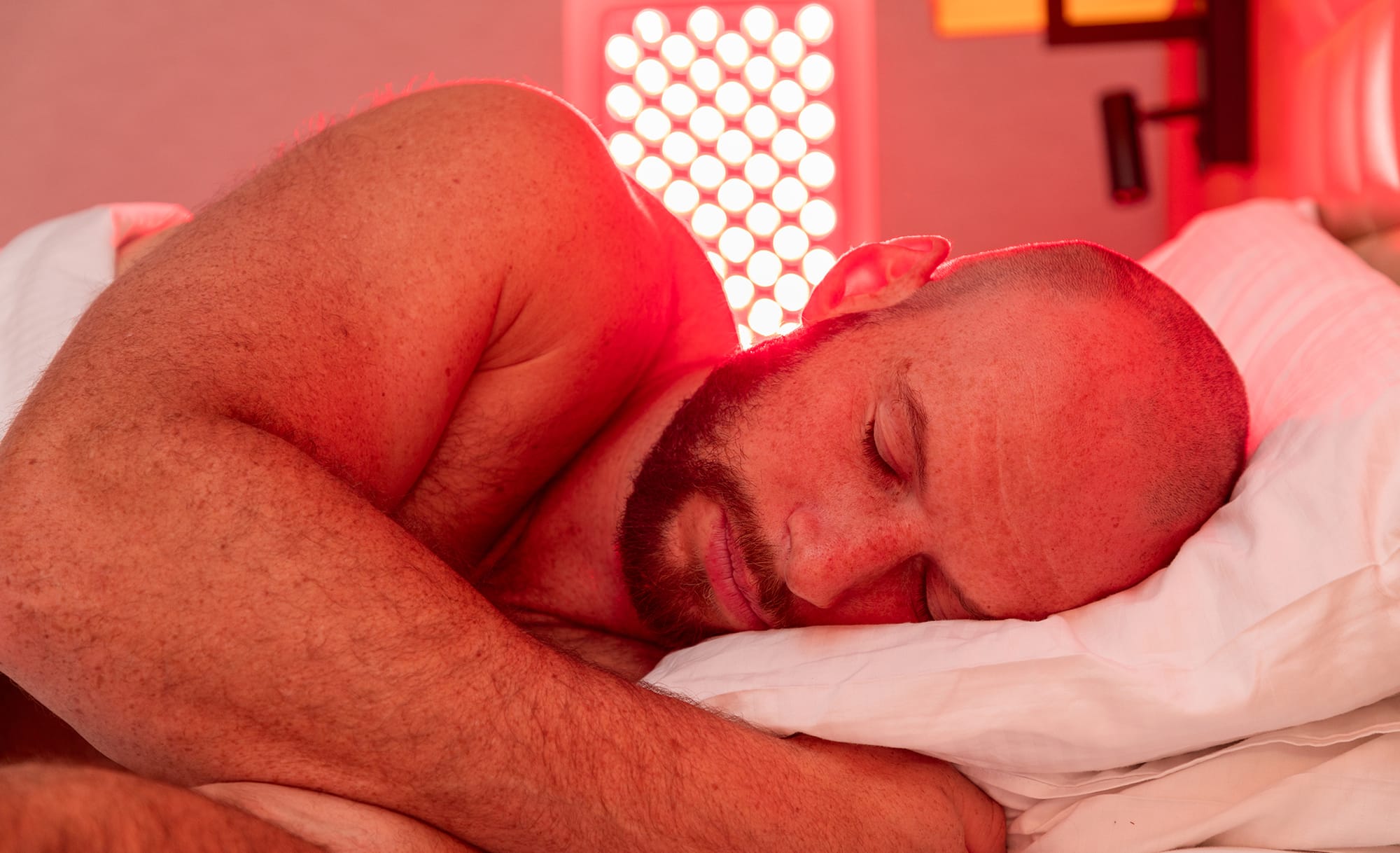
So what's the insomnia light therapy link? This option is circadian light therapy - where you use bright light in the morning and during the day to improve sleep at night.
Blue and green light are beneficial here to promote wakefulness. But even ultraviolet light has extensive benefits of its own. So, unless you're living at a very high latitude where it's incredibly dark in the winter, sunlight is still your best option.
So let's explore some other studies that consider insomnia, light therapy, sleep quality, and their interaction:
- Sunlight has an amazing track record for helping people sleep better (8; 9; 10; 11; 12; 13; 14; 15). Sunlight is great for sleep onset, duration, and quality, in children, adults, and the elderly. Sunlight also helps your body build vitamin D in the skin--while vitamin D deficiency is related to sleep problems.
- Bright light in the morning can also help sleep - even if it's not from the sun (16; 17; 18; 19; 20; 21; 22; 23; 24; 25; 26). Mood improves here, as well as daytime wakefulness. And, sleep quality at night is enhanced as well. You can use an SAD lamp for this effect, or even simply an old-fashioned strong halogen floodlight or several high-wattage incandescent lamps.
- Although technically not light therapy, I recommend avoiding bright light at night (27; 28; 29; 30; 31; 32; 33; 34; 35; 36; 37; 38). Blue and green light surpress melatonin production in the evening and at night - common sources are screens and artificial light sources. Light exposure at night is also detrimental to sleep quality - the green and blue are the main cultprits here again. I mention this because I return to the topic of the benefits of sleeping with red light later on.
So it's not just red light therapy for sleep that works - other light therapy sources can improve sleep quality also. Also, if you're interested, check the video below where Alex Fergus explains the science on this topic:
In this video, Alex Fergus gives you a basic introduction to the benefits of red light therapy for sleep.
Now, let's consider the timing of your red light therapy sessions:
Timing Matters: When To Use Red Light Therapy For Sleep?
Currently, there are no studies comparing red light therapy for sleep in the morning, afternoon, or night. So, the best option there is to rely on anecdotal evidence of experts.
For the best timing, I simply recommend experimenting. A pattern which has been observed in many people is that some people do really well with red light therapy in the evening, while for others, it's overstimulating.
If you're getting overstimulated after a red light therapy session - which can be explained through a dramatic increase in energy production, for instance - then it's better to do your red light therapy sessions during the morning, afternoon, or early evening.
If you feel great and are able to sleep perfectly after a red light therapy session, even though it's in the evening, by all means keep doing what you're doing! Until we've got more studies on this topic, there are no strict recommendations that can be made in this case.
Also, for the best results, get a wearable sleep tracker. The Oura Ring is an option many people love - a device that's highly accurate and continues to improve in its deep sleep and REM sleep tracking.
Next up:
Is There A Best Red Light Therapy Device for Sleep?
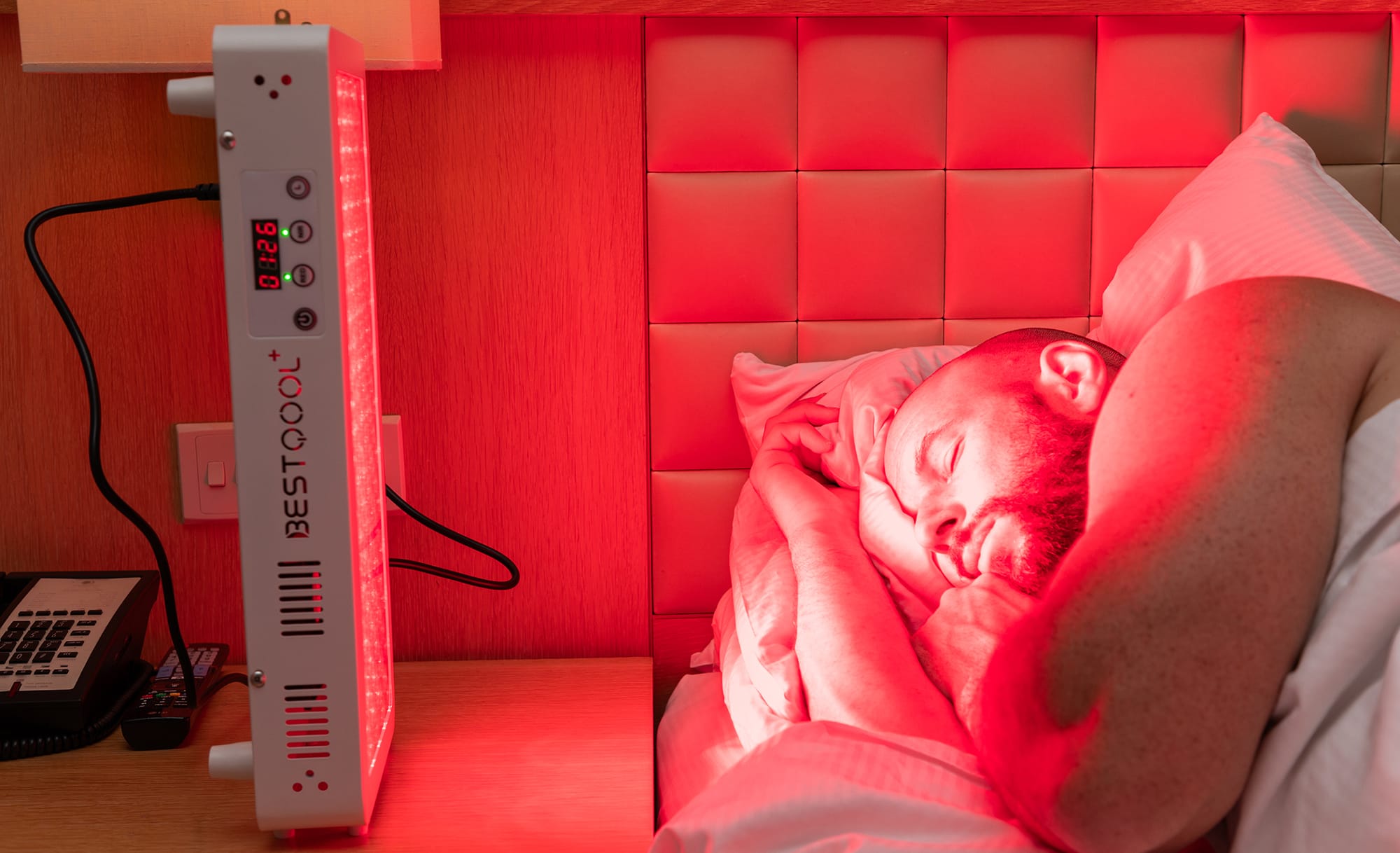
So, what's the best red light therapy device for sleep? There's not a simple answer here. The studies I've discussed before all use a different setup. With setup, I mean that varying devices are used, which emit different wavelengths of red light, for different durations and intensities, with different participants, and so forth.
Also, let's have a look at the red light therapy devices for sleep that have been used in the studies so far:
- The first study used a desk lamp, with 5 mW/cm power output, with 850nm light (1).
- The second study I considered uses the NovoTHOR bed (3). The NovoTHOR emits 660nm and 850nm light and around 16.7 mW/cm2, but very evenly across the entire body.
- Regarding the third study, I cannot see much regarding the setup (5). The only thing known was that the red light therapy was applied to the forehead.
- Then, lastly, the fourth study used a full body bed as well but with 660nm only (6).
Out of these studies, the full body red light therapy applications showed the best results by far. Why? Applying red light therapy to the head leads to decent results, but full body seems better, given the studies above.
So let's check a few options if you want a big enough setup for maximum results. I'll begin with Alex Fergus' comparison of the bigger panel on the market:
Also, if you want to understand the concept of full-body treatment better, I recommend checking the following two videos that I post below. These videos explain the coverage that you can expect when you're using a red light therapy panel:
Here Alex creates an experiment showing how much light exposure you can expect from one bigger panel.
Next up, the same experiment with multiple panels - essentially a full-body setup:
This video demonstrates that you can get great full-body coverage, even at a distance, from multiple bigger red light therapy panels.
Again, you'll ideally want full body coverage as well as a higher power output, for deeper pentration into the body. Finally, you may want to check out the body panels listed here for even more coverage:
Moving on to another important topic:
Expert Tips How To Use Red Light Therapy For Sleep
Next up, what do several experts say about how to use red light therapy for sleep? The topic is complicated. As stated before, you'll have to experiment with using red light therapy either during the daytime or early evening. Some people do really well with red light therapy before bed but it's not the rule.
Secondly, ensure that you're using a deep tissue treatment protocol. Most companies now supply you with information on how to use products for deep tissue treatment. The reason I recommend deep tissue treatment is because the studies with the best outcomes using full body red light therapy beds show results with higher power outputs.
Thirdly, you'll have to realize that red light therapy is just one factor among many affecting sleep quality. I don't want to go too deeply into this topic, but many other factors can have a massive influence on sleep quality. Examples are your nutritional levels and magnesium levels in particular, whether you mouth breathe at night or through your nose, air quality, potential noise pollution, room temperature, toxins in the mattress or other fabrics in your sleep environment, how well you treat your circadian rhythm, EMFs, (chronic) psychological stress, and many more.
Good or bad sleep is not determined by one factor. And yet, red light therapy will move the needle into the right direction. You'll still have to consider red light therapy for sleep one tool in the toolbox though!
Hence, if you've got horrible psychological stress, are living to a noisy and pollutive road, have a magnesium and zinc deficiency, and breathe through your mouth and snore, red light therapy won't fix all your problems. But, you will sleep slightly better, which is a huge benefit for many people already.
Sleeping With Red Light Therapy: Is It a Good Idea?
Sometimes people ask me: "But isn't sleeping with red light therapy a good idea?" Or "Why shouldn't you have red lights on at night?"
The simple answer is that you can, especially if the light isn't too bright. Bright light sometimes overstimulates people, even if it's red light. But red light at night is the healthiest option you can pick out of all visible colors.
The reason is that red light is still visible while not suppressing melatonin levels in your brain. You can use specialized red light bulbs for sleep that aren't too intense. So, a small red or amber bed light is great. But, you don't need to have a red light therapy panel activated at the full intensity - that's most likely counterproductive.
Overall though, I do really support red light bulbs in the evening and at night. The more artificial blue and green light you can block out from the environment, the better your sleep will be.
The following few sections on morning sunlight and blocking blue light are based on the earlier work of Alex Fergus - the founder of this website.
Check out his argument for additional tips to increase sleep quality:
Red Light In The Morning: The Huge Morning Sunlight Benefits For Sleep!
So let's consider a few other strategies to improve your sleep quality. These strategies don't necessarily use red light therapy - but they are light therapy focused!
What if you are still struggling with poor sleep? And if you're wired and alert at night yet groggy and lethargic when your alarm clock screams out in the morning?
You’ve probably tried all sorts of things to fix this–supplements, sleep tracking devices, maybe even modifying your sleep environment–but have you ever considered that your daily environment could set the stage for how well you sleep at night?
Every day, there is a critical time that can make or break whether you will sleep well later that night. That time is in the morning - the first few hours after you wake up (and ideally around sunrise).
So, what should you be doing every morning for optimal sleep? The short answer is simple – get some sun! The long answer is explained below.
We Live In Perpetual Daylight
Chances are, unless you know a thing or two about blue light, your light/dark cycles are totally messed up. Your body may not even be experiencing a ‘dark’ environment anymore. What with all the artificial light from TV screens, smartphones, fridge lights…
In today’s modern world, you and I come home from work at the end of the ‘day’ and worship our second suns – screens & light bulbs. We consistently simulate second ‘day times’ long after sunset. Day after day, night after night.
No wonder we’re all tired; it’s never dark!
The first thing to do to improve your sleep is make your environment dark when the sun goes down - I'll cover this topic later in this article. That darkness comes down to cutting all blue and green light from your environment!
You also need to increase your light exposure in the morning. How does this help us sleep? There are three keywords here – serotonin, cortisol & melatonin!
Serotonin And Sleep
Every morning, if your body, face and eyes are exposed to sunlight your body will increase its production of serotonin (7, 8).
Serotonin, a neurotransmitter, regulates mood, appetite, memory, sleep and is primarily manufactured in the gut (and is why you should care for your gut if you want stable moods and sleep patterns!) It’s crazy to think that people will pop all sorts of side effect-laden drugs to alter their serotonin levels when they could simply pop their heads outside every morning.
But I digress.
So, how does serotonin help us sleep? Well, serotonin is a precursor to melatonin (keyword #2). Melatonin, as you probably know, helps control your sleep and wake cycles and is a potent antioxidant.
Not only does our morning sunlight exposure boost the amount of raw material needed to make melatonin, but by exposing our bodies to morning sun, our serotonin cycles stay aligned with ‘nature,’ peaking midafternoon and dropping off at night – synchronous to our body temperature and our cortisol patterns (if they are working correctly!).

We now know that serotonin:
- Should be highest during the day
- Sets the tone for melatonin production later in the evening
- Provides the building blocks for the melatonin hormone
- And sun light boosts serotonin production (in particular 480nm light)
So:
No sun equals inadequate serotonin. And inadequate serotonin equals poor levels of melatonin. And low melatonin levels equate bad sleep.
But Wait, There's More: Cortisol And Sleep
Cortisol is our 3rd keyword. Light doesn't only impact your sleep through serotonin... the hormone cortisol also plays a role. Cortisol and melatonin work in opposites – yin and yang, up & down, day and night…If we want to optimize our sleep, we must ensure our cortisol/melatonin rhythms are working correctly.

Bright light in the morning (i.e. sunlight) also increases production of cortisol like it does with serotonin (11, 12).
Before you all say ‘cortisol is bad’ remember we need cortisol, it gets us up in the morning and is a vital hormone to one’s health. If you have heard people bagging cortisol it's because chronic cortisol can be problematic... that and misaligned cortisol rhythms. If cortisol is up, melatonin is down, and vice versa.
We want cortisol up in the AM and then dropping down in the evening so we can sleep. It's not a coincidence that our (natural) light cycles mimic our (normal) cortisol levels. Remember - cortisol is going to mess with your sleep (and for the guys out there – your testosterone levels).

If you’re still not convinced on the importance of light cycles, have a look at these findings:
- Research has shown that morning light exposure is a critical factor when it comes to weight loss! One study found that (11):
"Even after controlling for all non-light exposure factors including food intake, sleep, activity, the influence of morning light on weight was considerable—it accounted for roughly 20% of the subject’s BMIs, meaning those with earlier light exposure weighed less."
- A paper in the published in Innovations in Clinical Neuroscience found that (12):
"...individuals who had exposure to sunlight in the early part of the day had DECREASED levels of cortisol later on in the evening"
What do these papers mean? Morning light and sunlight exposure, in general, are vital for one's health.
So if you find yourself wired and alert every night when you should be falling asleep, perhaps you need more morning sun exposure?!
Importance Of The Eye: How Blue Light Affects Sleep
Before you rush outside, knowing what to expose to the sun is essential. Though any exposure to bright light in the morning will be beneficial for sleep, the light exposure to the eye matters most.
Why the eye?
Note: the below paragraph is paraphrased from Dr Jack Kruse's Cold Thermogenesis 7 blog (13):
When you are sleeping, your eyes retina is turned off. The retina is extremely sensitive. Sun light to the eye sends a ‘wakeup’’ signal to the RPE (Retinal Pigment Epithelium) in the eye, which relays a message to the anterior pituitary gland. This gland releases hormones (testosterone, growth hormone etc.) in the morning. Without this signal, hormones are not released in the quantity we need for optimal health. Not only that, but this signal effects hormone release later on in the day.
Vitamin A plays a vital role in this signaling process. When light hits the eye, there is a protein in the retina called melanopsin that uses vitamin A to detect the light and also signal the brain that it’s daytime.
When it’s night time this signal is switched off. If you are deficient in vitamin A then the melanopsin protein cannot transfer this light signal to the brain, meaning the brain may not receive accurate night/day signals (impacting your circadian rhythm and in turn sleep). The easiest way to ensure you’re not deficient in vitamin A? Eat liver once a week.
Even melatonin (which controls sleep) released at sundown is impacted by this morning eye signal. Studies show that full-spectrum sunlight in the morning increases ocular melatonin levels at night. Without this ocular melatonin (made in the eye), your pineal gland cannot release melatonin after 4 hours of darkness at night.
So what should you do?
The first thing every morning is to go outside (not behind a window - as glass filters UV light), with no sunglasses, eyeglasses, or contacts (again, they all filter out light).
Look towards the sun (not at it, but off to the side) so that sunlight hits your face. The longer, the better. Twenty minutes is great but two minutes is better than nothing. Remember, wearing glasses filters the much-needed full-spectrum light!
Sunlight - Get Some! (Especially Morning Sunlight)
So there you have it, the secret to fixing your sleep is to get some sun! Who would have thought?! And if for whatever reason you can’t get outside every morning, then all is not lost. Studies show that sunlight exposure later in the day can also help with sleep at night (14).
What happens if you don’t live in a sunny part of the world? It doesn’t matter, even on a cloudy day, it is brighter outside than it is in a lit-up office building. And sunlight – even through clouds – is full spectrum light, unlike many modern lightbulbs. Alternatively, you could look at using an SAD lamp. I've reviewed an SAD lamp below:
Before I let you run outside, you’re probably wondering what exactly ‘light exposure’ entails? Well, we covered the importance of getting sun in the eye, but you also want to maximize the coverage on your skin as well. And make sure its naked/unprotected skin (and eyes). So, no sunscreen (filters light), minimal clothing, no contacts, no glasses, etc.
At a minimum, you should expose your face to sunlight (or towards the direction of the sun) for a few minutes every morning and during the day.
How Blue Light Affects Sleep Negatively (And How to Fix It)
Humans need sleep. We die if we don’t sleep for 10 days. Studies have shown that a third of American adults are chronically sleep-deprived (15). Lack of sleep negatively affects memory, creativity, the immune system, muscle repair, inflammation, hormone levels, and even body fat.
So what’s causing all these sleep issues? Is it the high amounts of caffeine? Or the stress of work that keeping us up all night? These could be factors, but there’s something bigger than stimulants or stress. That factor plays a vital role in our lives, regulating far more than just our sleep. This factor affects every cell in our body, immune system, mood, and hormones.
What holds such power?
Light.
Light As Waves
When one thinks of light, they generally imagine the visible light, which allows us to see. Switching a light bulb on produces light (and other forms of energy such as heat). But there is a lot more to light than the colors of the rainbow. Visible light is only a tiny part of the electromagnetic spectrum.
This spectrum is a range of frequencies or varying wavelengths of energy:

There is a lot more to light than meets the eye, or should I say, appears to meet the eye.
For this article, we are going to focus on the visible light spectrum ranging from about 390nm to 700nm. With changing wavelengths, we see different colours. Pretty, sure, but these varying wavelengths cause different effects on the body.
How does light affect mood, hormones, and more importantly, sleep? It’s all about your circadian rhythm.
Circadian Rhythm
The term circadian rhythm comes from the Latin words circa (meaning approximately) and diem (day). The most obvious circadian rhythm is the sleep-wake cycle, though other circadian rhythms exist, such as rhythms in body temperature, hormone release, and even gene expression (16).
Everyone has slightly different circadian rhythms, but on average, the length is 24 and a quarter hours (17). Night owls will have slightly longer circadian rhythms, while early birds have shorter ones.

As mentioned before, circadian rhythms do more than simply tell the body when to be asleep or awake; they also influence the hormones released.
Hormones are powerful things. If your circadian rhythm is out of whack your body could be releasing cortisol late at night instead of first thing in your morning, which would leave you feeling groggy in the morning and wide awake late at night. Sound familiar?
So, how do the body and circadian rhythm keep track of time? The same way humans do - by using clocks! Scientists have found that nearly every cell in the body keeps track of time.
Here's a great explanation (19):
“Every 24 hours, responding to a biochemical bugle call, a handful of proteins assembles in the cell’s nucleus. When they bind to each other on the genome, they become a team of unrivaled impact: Under their influence, thousands of genes are transcribed into proteins. The gears of the cell jolt into motion, the tissue comes alive, and on the level of the organism, you open your eyes and feel a little hungry for breakfast.”
These cell clocks, appropriately known as circadian clocks work by responding to light and darkness cues from the suprachiasmatic nucleus located in the hypothalamus. Functions that are regularly carried about in the body can be traced back to the cell’s circadian clocks.
Hair cells, for example, divide at a particular time every evening. The liver releases enzymes to assist digestion at mealtime (which is why I recommend eating consistently every day), and the body prepares for sleep in the evening - assuming these clocks are working correctly!
Now that we understand how our body keeps track of time, it’s easier to understand how the circadian rhythm impacts our hormones, how we feel, and perform. The body likes and expects routine. Can you see why you feel so horrible after travelling across multiple time zones?
Health Depends On Circadian Cycles
The body runs on circadian cycles. Some functions happen at night, others during the day. When one is healthy, the clocks are in sync and the body's activities properly coordinated.
A disruption of this coordination not only leads to a feeling of perpetual jet-lagged, but also:
- Higher rates of cancer
- Diabetes
- Heart disease
- Obesity
- Insulin resistance (leading to diabetes)
- Leptin resistance
Along with these health issues, misfiring circadian rhythms are linked to memory and learning inhibition (20). This is why resetting your circadian rhythm can be the most effective way of improving not only your sleep but also your health.
Most of us have experienced how long-haul flights can disrupt our circadian rhythm, but there is a multitude of other factors that can mess with our circadian rhythm. A study published earlier this month in Science Translational Medicine found that “caffeine at night delays the human circadian clock” (21).
Researchers found that 200mg of caffeine (equivalent to a double espresso) 3 hours before bedtime created a 40-minute phase delay in the test subjects’ biological clocks. They showed that caffeine had a direct effect on the internal clocks in human cells.
Drinking coffee at night affects sleep. No surprises there. This same study, however, had an interesting finding that was overlooked by the media.
The researchers not only tested how caffeine affected circadian rhythm, but they also looked at the light. The outcome – bright light delays one’s circadian rhythm more than of a double espresso does - a lot more, in fact.
Stone Hearth Newsletters reported the following on these findings:
"Bright light alone [...] induced circadian phase delays in the test subjects of about 85 minutes.” Double that of the caffeine-drinking group.
Yes, you read that right. Bright light delayed the circadian rhythm by twice as long as a double espresso.
Light and Its Impact On Circadian Rhythm
Our body is constantly receiving signals from our environment. One of the most important yet often overlooked signals is that of light or the lack thereof. If we go back to 1878, before Thomas Edison invented the light bulb, our light sources were limited to fire (candles) and the moon once the sun went down.
There were no TVs, no smartphones, no digital alarm clocks, and not even a blinking LED from a smoke detector! The body’s exposure to light past sundown was extremely low.
If we think about the hundreds of thousands of years of human evolution and adaptation to our environment, 150 years is nothing. Our bodies live in light and dark cycles. When it was dark, we were restricted to low-light activities such as reading, writing, talking, having sex, and obviously, sleeping. When the sun was up we fished, hunted, made shelters, played, and worked.
Our bodies and circadian rhythm evolved based on this light-dark cycle. Today, 138 years after the invention of the light bulb, our bodies are still programmed to function in this light-dark cycle.
If you’re thinking that instead of going outside every morning, you’ll just turn the lights on in your room, I need to point something out: it’s not the same. It’s all about lux. Lux is a measure of light brightness as seen by the human eye.
For comparison purposes, moonlight is about 1 lux. A brightly lit office is about 400 lux. An overcast day is about 2,000 lux. A spring day is about 40,000 - 60,000 lux. Bright summer sunlight is about 120,000 lux!
Can you see why getting outside is so important? Not to mention the beneficial effects of UV exposure on the skin.
You can actually test this for yourself. Download a lux meter on your phone and take some readings. I don’t know how accurate these apps are, but it should provide some insight into brightness levels.
Finally, I need to point out that the body senses light not only through the eyes but through the skin as well (22). In fact, vitamin D is synthesized in the liver and kidneys through the skin’s exposure to UV-B light. So when you’re outside, be sure to expose as much skin as possible.
Takeaway: Morning sun exposure is vital for optimal circadian rhythm functioning. If you work indoors, aim to go outside for brief spells during the day.
Light Types And Their Circadian Rhythm Impact: Common Blue Light Exposure Sources
Light itself is the most crucial factor in setting our circadian rhythm. There are different colors in the visible light spectrum, and different colors have different wavelengths. Different wavelengths of energy cause different biological effects on our bodies. For example, it has been shown that a specific wavelength of red light can regrow tooth dentine and infrared saunas have been shown to have health beneficial detoxifying effects (23).
When looking at the wavelength of light that impacts circadian rhythms, studies have shown that blue and UV lights have the most impact. From an evolutionary perspective this makes perfect sense - blue light comes from the sun, with the highest levels of blue light reaching Earth around midday. As the sun starts to go down, the light becomes orange and red in color. If you have watched a sunset (or even a sunrise), you have noticed how the color is very red when compared to a white midday sun.
If we travel back to the 1800s again, we were only exposed to blue light (or UV light) during the day. Come sundown, light sources would have been restricted to candles and fire. If you look at the image below, you can see how the candle puts out primarily orange and red light with very little blue and UV wavelength light.

Understanding the difference between light colours is important if you want to optimize your circadian rhythm, sleep, and health.
I should also point out that when I talk about blue light it doesn’t have to be solely blue light. White light (from a fluorescent bulb or midday sun for example) is comprised of blue light.
The following image does a great job of showing the colour frequencies that make up various light sources:

You will notice how modern LED and fluorescent light bulbs actually put out a lot more blue and green light than a traditional candle or even an incandescent light bulb.
Takeaway: Sunlight, which is up to 100 times more powerful than room light in the blue and UV spectrum, is the best type of light for setting circadian rhythms.
Blue Light and Melatonin
What is the connection between light, circadian rhythm, and sleep? The answer is melatonin.
Melatonin is a hormone secreted by the pineal gland in response to darkness. It is commonly referred to as "the sleep hormone," but it also plays a vital role in controlling inflammation levels in our body while aiding our immune system (this is why, if you have a few nights of insufficient sleep, you’ll often catch a bug or become run down). It achieves this through its antioxidant properties. When people ask me what antioxidant supplements they should take I tell them to save their money and get their sleep back on track first.
Melatonin is generated after about 4 hours of darkness (the kind where you can’t see your hand in front of your face ) and generally peaks around 2am.
It runs opposite to cortisol: when melatonin is high, cortisol is low in this state, you should be sleepy. When melatonin is low, cortisol is high, you should feel alert and energized for the day. A good picture of this relationship can be seen here:

Melatonin is also the link between sleep and fat loss, as melatonin causes leptin to be released during sleep. Leptin (the hormone that causes you to feel full after a meal) enters the hypothalamus, your thyroid is up-regulated, your metabolism increases, growth hormone is released, and the body burns fat.
Circadian dysfunction is linked to obesity and it appears that leptin is the key. Researchers are finding that circadian clock deficiency or chronic jet lag leads to leptin resistance, and leptin resistance creates hormonal irregularity and fat gain. This is the body fat that, no matter how hard you train or how strict your diet, just won't go away. Hormonal cycles are crucial not only for sleep but for maintaining a healthy weight.
As we outlined above, light and blue light, in particular, affects our circadian rhythm. Light influences melatonin secretion, with blue light having a far greater impact than red light.
The Harvard Health Publication sums it up nicely:
"While light of any kind can suppress the secretion of melatonin, blue light does so more powerfully. Harvard researchers and their colleagues conducted an experiment comparing the effects of 6.5 hours of exposure to blue light to exposure to green light of comparable brightness. The blue light suppressed melatonin for about twice as long as the green light and shifted circadian rhythms by twice as much (3 hours vs. 1.5 hours)" (26).
Modern technology is the worst source of blue light in today’s environment. A study appearing in The Proceedings of the National Academy of Sciences titled, “Evening use of light-emitting eReaders Negatively Affects Sleep, Circadian Timing And Next Morning Alertness” found that "The use of light-emitting electronic devices [...] before bedtime prolongs the time it takes to fall asleep, delays the circadian clock, suppresses [...] melatonin, reduces the amount and delays the timing of REM sleep, and reduces alertness the following morning" (27).
Another on fruit flies found that a single pulse of light to the brain was enough to disrupt circadian rhythm by 2 hours (28)!
If you’re still not convinced that artificial light at night can impact circadian rhythm, melatonin secretion, and sleep, then here are a few more studies to prove my point:
One more study found that,
"Compared with dim light, exposure to room light before bedtime suppressed melatonin, resulting in a later melatonin onset in 99.0% of individuals and shortening melatonin duration by about 90 min. Also, exposure to room light during the usual hours of sleep suppressed melatonin by greater than 50% in most (85%) trials" (29).
In another study, dim light exposure at night was shown to disrupt circadian rhythms and lead to an increase in bodyweight (30). The study used a light source emitting 5 luxes of light. Remember, moonlight is about 1 lux. So that green charging light glowing on your bedside table could be impacting your sleep.
Finally, if you have light-coloured eyes you need to be even more careful about night time light, as it has been shown that your eye colour can affect melatonin secretion (31).
So, which sources of artificial light emit blue light? Let’s look again at that chart from earlier:

We can see that modern LED and fluorescent lights contain high amounts of blue light. The researchers who created this chart also tested how each light source affected melatonin and found that high levels of blue light had the greatest effect on melatonin suppression. Brightness was also a determining factor.
There’s an excellent site called fluxometer that shows you the light output of various devices, ranging from the iPhone to streetlights. I recommend heading over there and playing around. It will also show how bright the light from a device is compared to daylight, and the resulting circadian rhythm phase shift. Here's a screenshot from the iPhone 6 report:

Takeaway: Light exposure at night shuts down melatonin production with blue light having a huge impact compared to red light. Blue light sources include modern light bulbs, computer screens, cell phones, and TVs.
Light in the 21st Century: Mitigating Blue Light's Effects
From an evolutionary perspective, blue light impacting melatonin makes perfect sense. Prior to 1878 the only time we were exposed to blue light would have been during the day. We are diurnal (daytime) creatures, programmed to be outdoors when the sun is shining and home in bed when it is not. Nighttime = darkness, and darkness = sleep.
However, we don’t live in the 1800s. Light is available 24 hours a day. We all carry light-emitting devices such as the phones in our pockets. If it’s the middle of winter and the days are short, we play God and turn on energy-efficient ultra-white light bulbs, which give off more blue light than older incandescent bulbs. We then watch TV or work at our LED backlit laptops with screens that emit more white light than older technology displays.
If that’s not enough of a light assault on our body, we get into bed and hold a screen inches from our face. The icing on the cake is the blue LED blinking right next to us as our array of devices charges while light from the LED streetlamp outside seeps in through the curtains! Jack Kruse sums it up nicely (32):
“Every time we look at our phone, we send a signal to the brain that the sun is up.”
If you think all of this is crazy, take a look at astronauts who become susceptible to a wide range of diseases due to being in space. When in orbit, astronauts experience 19 sunrises and sunsets in a 24-hour period. This is what happens when you take something out of the environment it was designed to live in.
People understand this in the context of space and illness, yet every night here on planet Earth, we flash signals to the brain that the sun is rising. We then blame our health and sleep woes on uncomfortable mattresses or a stressful day.
The solution to improving our sleep is simple: eliminate artificial light at night. A 2013 study even found that one week of camping with no artificial lights (not even flashlights), synchronized the circadian clocks of the eight study subjects with the timing of sunrise and sunset (33).
Living An Ancestral Life In A Modern World
So let’s summarize what we have learned so far. We know that:
- Sleep is important for health and controlling body fat levels
- One of the best ways to improve sleep is to reset your circadian rhythm. A poor circadian rhythm is also linked to various health conditions.
- Light plays a huge role in setting our circadian rhythm.
- Blue light in particular can disturb our circadian rhythm and negatively impact melatonin secretion.
- We are surrounded by blue light-emitting sources, something that humans have only been exposed to in very recent times.
- To fix your circadian rhythm, your sleep, and your health, you need to maximize light exposure in the morning and during the day, and reduce light exposure come sundown.
How can you achieve all of this? One option is to escape from the grid and move into the bush without any electricity. That would work.
But for those of us who enjoy the world we live in with all its marvellous technology, we can still control the kind of light we expose ourselves to.
You can probably guess how. In a nutshell, it involves:
- Increasing exposure to blue light and UV light in the morning and middle of the day
- Decreasing exposure to blue light and UV light in the evening and at night.
Who would have thought? Expose yourself to the sun when the sun is up and avoid light (artificial light) when the sun is down!
Let’s look at some practical steps to help us make this a reality.
Increasing light during the day:
- Get outside within 30 minutes of waking up. Aim to maximize skin and eye exposure to the sun. This means no glasses and ideally, your shirt off. Twenty minutes is a good amount, but even 5 minutes will be beneficial.
- If you work indoors, take breaks every few hours and go outside. If possible, work in a well-lit environment (ideally from natural light).
- During your lunch break, get outside for a good dose of UV-B sunlight. UV-B is needed for vitamin D synthesis and only hits the Earth’s surface around the middle of the day.
Decreasing light exposure at night:
- Replace all your LED and fluorescent light bulbs with incandescent bulbs. Yes, they are more expensive to run, but think of the extra cost as an investment in your health. If you must use lights, use a RED LED night light. Better yet, simply use candles!
- Within an hour of sunset, switch off all overhead lights, especially if they are newer LED or fluorescent lights. Instead, light candles (or you can use less than-optimal LED fake candles). Alternatively, use a low wattage incandescent Himalayan rock salt lamp. I use one at my apartment and it puts out a nice orange hue while releasing beneficial negative ions.
- If you want to read in bed but don’t want to read by candle light, use a low wattage incandescent light bulb (15w or lower is best) in your bedside lamp. If you can get your hands on a RED lightbulb that would also help.
- If you are serious about your health and sleep, restrict all artificial light sources 2 hours prior to sleep: no TV, no computer, no phones, and no eReaders. Buy books instead of eBooks. Print out articles to read at night. Talk with your partner over candlelit dinner. Listen to the radio. Play board games. Switch off. Relax
- If you must use a screen in the hours leading up to bed, install f.lux. F.lux is software that changes the colour of your screen based on your time zone. As the sun goes down, the screen becomes tinted red as the blue frequencies are reduced. On your phone, try the Twilight app for Android. F.lux is available for iPhone but only on jailbroken devices. If you don't want to jailbreak, I recommend (and use) a blue blocking phone filter by Pavoscreen that reduces blue light emittance. I actually use this along with f.lux and I wear my bluelightblocking glasses (code FERGUS saves)! Another option is to invert the colours of your iPhone screen. If you’re watching TV, play around with the colour temperature and brightness settings to reduce blue light.
- Wear Blue Blocker glasses (again code FERGUS saves). These are vital if you are going to be looking at screens late at night (even if f.lux is installed). Yes, they may look dorky, but there are some stylish Blue Blocker glasses coming out. They’re great for those times you have to use your phone right before bed. I wear them and so does my girlfriend. I can tell you, they help drastically!
- Next to Swanwick which I've listed above, there are other brands offering blue-light blocking glasses as well. Examples here are Boncharge, Chroma, Red Light Rising and Block Blue Light (discount code ALEX saves with all of them!)
- Sleep in a pitch-black room. You shouldn’t be able to see your hand in front of your face. Cover any crack that leaks light with duct tape. Install black-out curtains and put towels at the base of doors. The apartment I live in is next door to a multi-level, 24-hour car parking lot. We could only eliminate the light leakage by sticking tin foil across the windows and using black-out curtains. Sleep is that important!
- Turn off or cover any electronic devices that glow or put out light. Your room needs to be pitch black all night. Replace digital clocks with analogue clocks.
- Wear an eye mask. Even though our skin senses light, our eyes are the primary sensors. Studies have shown that even a small amount of light perceived through closed eyelids can disrupt circadian rhythm and sleep quality.
- If you must get up during the night, don’t turn on the main lights. If you really need light to go to the loo, look at having a low-wattage incandescent lamp or a Red LED night light in the bathroom. Block Blue Light has some great bulbs here!
Conclusion: The Red Light Therapy Sleep Benefits Are Truly Exciting
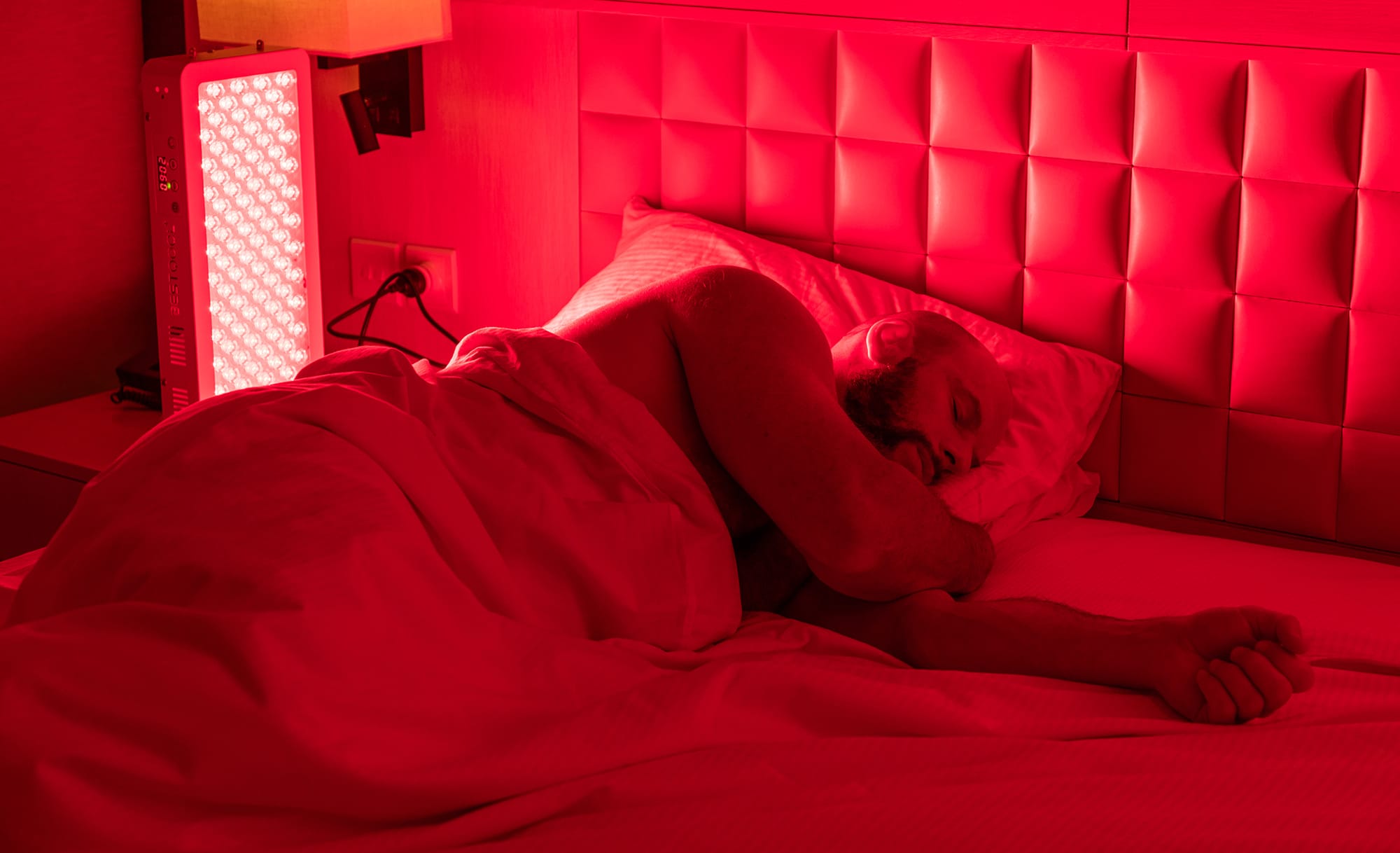
Hopefully, I convinced you that the red light therapy sleep benefits are the real deal. Even without many scientific studies, you can still learn a few lessons from them. Full-body treatments are better than treating smallar parts of the and you'll need decent power density for the full benefits.
Also, red lights for bedroom are great too for allowing your melatonin levels to rise. You can use such bulbs throughout the house in the evening for the best effects. Lastly, for the best effects, get some natural light exposure from sunlight too, during the morning and afternoon.
And, hopefully with the tips of Alex on morning sunlight and avoiding blue light at night you've got much better tools to improve sleep quality! The best results, here, are achieved when you combine all of these tips!
Frequently Asked Questions
Below I'll answer a few frequently asked questions about red light therapy for sleep:
Can I Use Red Light Therapy And Blue Light Therapy Together for Sleep?
Yes, during the day, you can use red light therapy and blue light therapy together for sleep. Blue light therapy tells your body it's daytime and improves your wakefulness.
Ideally, you shouldn't use blue light therapy at night because it can keep you up. Using blue light therapy at night is like drinking a cup of coffee before bed - for almost everyone, sleep quality tends to go down in that case.
What Other Colors of Light Can Enhance Sleep Besides Red?
Amber, found between 600 and 620nm light, is also frequently used as a sleep light. But, the effects are very similar to a red light. Both amber and red light don't surpress melatonin, so sleep quality improves.
Some people ask "does red light produce melatonin?" The answer is no here - red ligth allows melatonin to rise in your brain, as does amber, but it doesn't produce melatonin by itself.
Is It Safe To Use Red Light Therapy Daily For Sleep?
In the studies performed so far, red light therapy is safe to use daily for sleep, yes. Anecdotally, some people do better when they take a day off every week and don't use red light therapy seven days a week. Again, there is no hard science on this topic, so you'll have to use trial and error.
Does Red Light Produce Melatonin?
The absence of blue and green light in the human eye is what creates melatonin. So, red light by itself doesn't produce melatonin because you'll get the same effect in complete darkness.
Is Red Light Therapy Good For Babies' Sleep?
Technically, there are no studies on red light therapy for babies' sleep. However, an amber or red light in the babies' bedroom can be extremely helpful for creating a healthy sleeping environment, as their melatonin levels are also negatively affected if you've got green or blue lights in the room.
Alex Fergus wrote this blog post. Alex is an ISSN Sports Nutrition Specialist, Fitness Professional, and certified Superhuman Coach who continues to expand his knowledge base and help people worldwide with their health and wellness. Alex is recognized as the National Record Holder in Powerlifting and Indoor Rowing and has earned the title of the Australian National Natural Bodybuilding Champion. Having worked as a health coach and personal trainer for over a decade, Alex now researches all things health and wellness and shares his findings on this blog.
This is a post by Bart Wolbers. Bart finished degrees in Physical Therapy (B), Philosophy (BA and MA), Philosophy of Science and Technology (MS - with distinction), and Clinical Health Science (MS), has had training in functional medicine, and is currently chief science writer at Lighttherapyinsiders.com
Found This Interesting? Then You Might Like:
- Start Here - Light Therapy 101 & Buyers Guide
- Discount Codes, Deals & Recommendations - Red Light Therapy
- What Is Red Light Therapy?


